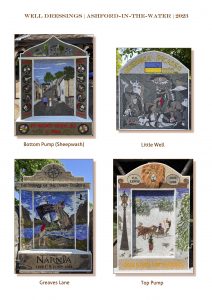Well Dressing
Well Dressing in Ashford-in-the-Water
In 2024, Ashford-in-the-Water’s Well Dressing and Flower Festival run concurrently from Saturday 25th May to Sunday 2nd June.
See the full schedule of events here.

What is a Well Dressing?
The six village wells are dressed annually and are erected the day before Trinity Sunday. They remain in place for the following week.
A Flower Festival is held in the church at the same time, to celebrate the Trinity to which the church is dedicated.
The custom is almost exclusive to Derbyshire and is only found in or very close to the county. In its simplest form Well Dressing can be described as the art of decorating springs and wells with pictures made from local plant life: flower petals, berries and leaves as well as other natural materials such as dried herbs, pulses, seeds, stones and wool.
It is thought that well dressing originated in pagan times as a form of thanking the water gods for clean water. Sacrifices took both human and animal form, but gradually the cruelty and wastefulness of this method of giving thanks gave way to primitive man hanging garlands of flowers over the wells. This then developed into creating pictures in clay on boards that were, and still are, displayed at the wells.
The Making of a Well Dressing.
The base of each well dressing is clay smothered onto wooden slatted boards. These wooden well boards are put into the river and anchored down with stones a fortnight before Trinity Sunday. They are left there for a week to soak up as much water as possible, then brought out a week later and filled with clay, in a process known as “puddling”.
The design for the well is drawn on paper to the size of the board and is then laid on top of the clay. The outline is transferred to the clay by pricking through the paper with cocktail sticks. The paper is peeled back a little at a time and the ‘pricked’ outline is then marked with wool or other natural materials such as hen corn, alder-bobs, melon seeds, maize or aniseed.
Once the outlines are all marked and the paper is removed the “dressing” can commence. First dried material is pushed into the clay. This could be oatmeal, lichen, shells, seeds, stones or “churchyard sweepings” – the tiny, fallen flowers of the yew tree which are a beautiful golden colour. Faces, hands and feet are also made at this stage and can be the most difficult part. Different shades of eggshell are used for the flesh and small pieces of aniseed for hair and beards. Eyes are pieces of coal or coffee beans, depending on the size of the face.
Next go in long-lasting leaves and stems. Fresh parsley is often used, also small pieces of conifer and ‘bendy’ stems like honeysuckle. Once the background is completed the ‘petalling’ can start and the picture begins to take shape. Flowers with ‘hard’ petals, such as hydrangeas which will last the week are used. Tiny flower heads, like forget-me-nots can be poked in whole, with cocktail sticks, cow parsley is broken up into tiny sprigs and others go in petal by petal, working from bottom to top of the picture and overlapping in a method that resembles slating a roof, this helps to shed any rain.
The finished well is a wonder to behold. The edge of the board is then touched up with paint and left to dry, before the ‘heavy brigade’ of strong men with their tractors take the dressed board to its well and erect it very early on the Saturday morning. This beautiful work of art remains for a week for you all to enjoy.
A Well Blessing Service is held at 3pm in Holy Trinity church on Trinity Sunday, with the sermon being preached from the steps of the old preaching cross in the churchyard, weather permitting. One of the local Brass or Silver Bands, followed by the church choir and the clergy, then leads a procession to bless each well.

